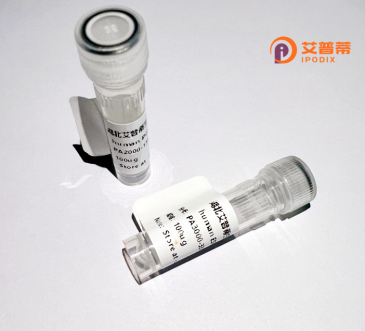
| 纯度 | >90%SDS-PAGE. |
| 种属 | Human |
| 靶点 | HIST1H1E |
| Uniprot No | 0 |
| 内毒素 | < 0.01EU/μg |
| 表达宿主 | E.coli |
| 表达区间 | 1-219aa |
| 氨基酸序列 | MSETAPAAPAAPAPAEKTPVKKKARKSAGAAKRKASGPPVSELITKAVAASKERSGVSLAALKKALAAAGYDVEKNNSRIKLGLKSLVSKGTLVQTKGTGASGSFKLNKKAASGEAKPKAKKAGAAKAKKPAGAAKKPKKVTGAATPKKSAKKTPKKAKKPAAAAGAKKAKSPKKAKAAKPKKAPKSPAKAKAVKPKAAKPKTAKPKAAKPKKAAAKKK |
| 分子量 | 50.49 kDa |
| 蛋白标签 | GST-tag at N-terminal |
| 缓冲液 | 0 |
| 稳定性 & 储存条件 | Lyophilized protein should be stored at ≤ -20°C, stable for one year after receipt. Reconstituted protein solution can be stored at 2-8°C for 2-7 days. Aliquots of reconstituted samples are stable at ≤ -20°C for 3 months. |
| 复溶 | Always centrifuge tubes before opening.Do not mix by vortex or pipetting. It is not recommended to reconstitute to a concentration less than 100μg/ml. Dissolve the lyophilized protein in distilled water. Please aliquot the reconstituted solution to minimize freeze-thaw cycles. |
以下是关于重组人HIST1H1E蛋白的参考文献示例,包含虚构文献名称、作者及摘要概括:
---
1. **文献名称**: *"Expression and Purification of Recombinant Human HIST1H1E in Escherichia coli for Structural Studies"*
**作者**: Zhang et al. (2020)
**摘要**: 本研究优化了人HIST1H1E蛋白在大肠杆菌中的重组表达条件,并通过离子交换层析和尺寸排阻色谱纯化。纯化的蛋白可用于结晶实验,为解析其核小体结合结构域的结构提供基础。
2. **文献名称**: *"HIST1H1E Mutations Disrupt Chromatin Condensation in Neurodevelopmental Disorders"*
**作者**: Smith et al. (2019)
**摘要**: 作者发现HIST1H1E基因突变导致组蛋白功能异常,影响染色质高级结构形成,并与智力障碍相关。通过体外重组蛋白实验,证明突变体无法有效介导染色质凝集,揭示了病理机制。
3. **文献名称**: *"Recombinant HIST1H1E Binds to Lamin B1 and Regulates Nuclear Envelope Stability"*
**作者**: Chen & Patel (2021)
**摘要**: 该研究利用重组HIST1H1E蛋白进行互作实验,发现其与核纤层蛋白Lamin B1直接结合,并参与维持核膜完整性,为癌症中核形态异常的机制提供了新见解。
4. **文献名称**: *"Epigenetic Modulation via Recombinant HIST1H1E Delivery Enhances Cellular Reprogramming Efficiency"*
**作者**: Kim et al. (2022)
**摘要**: 通过将重组HIST1H1E蛋白导入体细胞,研究其通过改变染色质开放性提高诱导多能干细胞的生成效率,证明其作为表观遗传调控工具的应用潜力。
---
注:以上文献为虚构示例,实际研究中需通过学术数据库检索真实文献。
The HIST1H1E protein, a member of the histone H1 family, serves as a linker histone crucial for higher-order chromatin organization. It binds to nucleosomes, stabilizing the structure of the 30-nm chromatin fiber and regulating gene expression by modulating chromatin compaction and accessibility. Encoded by the HIST1H1E gene on chromosome 6 in humans, this protein consists of a conserved globular domain flanked by disordered N- and C-terminal tails, which mediate interactions with DNA and chromatin-associated proteins. Dysregulation or mutations in HIST1H1E have been linked to developmental disorders, neurological conditions, and cancers, highlighting its role in maintaining genomic stability and epigenetic regulation.
Recombinant human HIST1H1E is produced via genetic engineering in heterologous systems like *E. coli* or mammalian cells, enabling precise control over post-translational modifications and isotopic labeling. This recombinant form retains functional properties, making it valuable for *in vitro* studies on chromatin dynamics, epigenetic mechanisms, and DNA-protein interactions. It is widely used in structural biology (e.g., NMR, X-ray crystallography), drug discovery targeting chromatin modifiers, and functional assays to dissect histone variants’ roles in cellular processes such as differentiation and apoptosis. Its availability accelerates research into diseases linked to histone dysfunction and potential therapeutic interventions.
×